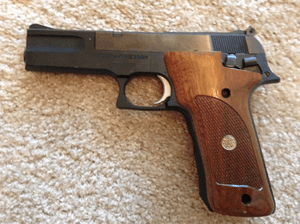Smith & Wesson Model 422
The Smith & Wesson Model 422, was a semi automatic .22LR pistol manufactured by Smith & Wesson.
| Smith & Wesson Model 422 | |
|---|---|
 | |
| Type | Semi-automatic pistol |
| Place of origin |
|
| Production history | |
| Manufacturer | Smith & Wesson |
| Produced | 1987-1996 |
| Specifications | |
| Weight | 22 (4.5") and 23.5 oz (6") |
| Length | 7.5" overall with 4.5" bbl |
|
| |
| Cartridge | .22 Long Rifle |
| Caliber | .22 |
| Barrels | 4.5" and 6" |
| Action | blowback |
| Effective firing range | 50 yds |
| Feed system | 10 or12 round box magazine |
| Sights | fixed (field) or adjustable (target) |
Production history
Produced from 1987-1996, the Model 422 was the company's entry into the lucrative mid-priced rimfire pistol market. This niche was, at the time, dominated by Sturm Ruger's highly successful Mk I and Mk II series of pistols. Smith & Wesson had previously left the market position after 1966, when the Model 46 was dropped from their catalog. The pistol retailed for roughly $250US before it was discontinued in 1996.[1]
Design Details
A very unique design feature of the 422, along with the Model 622 (stainless steel version of the 422), was the fact that the barrel, which was non-moving and was fixed to the frame, resided in a low position in the frame just above the trigger guard. The barrel came threaded from the factory, with a protective "barrel nut" fitted.
The bolt assembly, which comprised the top rearward portion of the pistol, moved behind as well as above the axis of the barrel and resembled an L shape. The recoil spring was contained in the portion above the bolt, which also housed the firing pin. Above the barrel was a large frame lug, which gave the gun a pleasing look of constant width and depth from the trigger guard forward to the muzzle, while also serving as a solid block for the bolt to hit against when the recoil spring returned the bolt to battery. The low bore axis served to greatly reduce muzzle jump, and served to allow the fitting of a suppressor without losing the use of the factory sights.[2] [3]
The model 422 was introduced with a 12 round detachable box magazine, but was later shipped with a 10 round box, in answer to a 1992 "hi-cap" magazine ban.[4]
Variants
- S&W 61:
- S&W 622:
- S&W 2206:
- S&W 2213:
- S&W 2214:
See also
References
- ↑ Fadala, Sam (2002). "Smith & Wesson's Model 41: collectibles, edibles, and a lesson in history". American Handgunner 22 (6): 83.
- ↑ http://www.genitron.com/Handgun/Smith-Wesson/Pistol/422-Field/22-LR/Variant-1
- ↑ http://vannuysgunshop.com/gun_manuals/smith_wesson/S&W%20422%20Rimfire%20Pistols.pdf
- ↑ http://oag.ca.gov/sites/all/files/agweb/pdfs/firearms/forms/awguide.pdf
| |||||||||||||||||||||||||||||||||||||||||||||||||||||||||||||||||||
